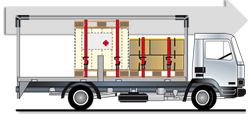Calculation of the stability of the vehicle structure, example 2
Blocking the load by form fitting in the direction of travel in a truck with non-slip matting.
Compared with the previous example, non-slip matting is then used for load securing in addition to interlocking. The result is clear:
Then the interlocking load securing is fulfilled!

| Abbreviation | value/unit/calculation | value | |
|
vehicle loading capacity Close
Load requirements for vehiclesEvery vehicle has a defined upper limit for the weight of the load being transported. This information is provided by the vehicle manufacturer. |
NL | 10 t | 10.000 daN |
|
effective load weight Close
Effective load weightThe effective load weight is the weight of the goods AND the packaging and any load securing material. |
FG | 10 t | 10.000 daN |
|
Acceleration coefficient Close
Acceleration coefficientThe acceleration coefficient is a dimensionless measure of the acceleration. The value of 0.8 given here is the standard value for deceleration used for CTU, EN, VDI. |
cx | 0,8 | |
|
Sliding friction of the loading surface Close
Sliding friction coefficient for the loading surfaceThe sliding friction coefficient (or friction coefficient) is a measurement (between 0 and 1) of the friction forcew in relation to the contact pressure between two bodies, between load and loading surface. The values are shown in the following table: |
µ | 0,6 | |
|
shifting force Close
Shifting forceThe shifting force is dependent on the weight being shifted and the acceleration acting on this weight. |
FV | FV = FG * c = 10.000 daN * 0,8 = | 8.000 daN |
|
Securing force of the front wall Close
Securing force for the end wallThe securing force for the end wall is 40% of the vehicle's load capacity for most vehicles. |
FSt | FSt = NL * 40 % = 10.000 daN * 0,4 = | 4.000 daN |
|
Friction Close
FrictionSpecifically "Friction force". This is related to the fliding friction coefficient and the weight of the load. |
FR | FR = FG * µ = 10.000 daN * 0,6 = | 6.000 daN |
| Difference | Δ | Δ = (FR+FSt)-FV | 2000 daN |

